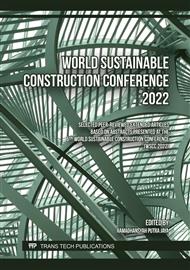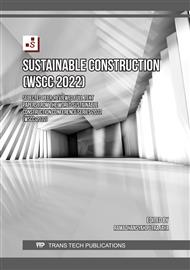[1]
M. Yazdani, K. Kabirifar, B. E. Frimpong, M. Shariati, M. Mirmozaffari & A. Boskabadi, Improving construction and demolition waste collection service in an urban area using a simheuristic approach: A case study in Sydney, Australia. Journal of Cleaner Production. (2021). 280, 124138.
DOI: 10.1016/j.jclepro.2020.124138
Google Scholar
[2]
M.S. Jain, A mini review on generation, handling, and initiatives to tackle construction and demolition waste in India. Environmental Technology & Innovation (2021). 22, 101490.
DOI: 10.1016/j.eti.2021.101490
Google Scholar
[3]
H. Wu, J. Zuo, H. Yuan, G. Zillante & J. Wang, Cross-regional mobility of construction and demolition waste in Australia: An exploratory study. Resources, Conservation and Recycling. (2020) 156, 104710.
DOI: 10.1016/j.resconrec.2020.104710
Google Scholar
[4]
Negash, Y. T., Hassan, A. M., Tseng, M. L., Wu, K. J., & Ali, M. H. Sustainable construction and demolition waste management in Somaliland: Regulatory barriers lead to technical and environmental barriers. Journal of Cleaner Production. (2021). 297, 126717.
DOI: 10.1016/j.jclepro.2021.126717
Google Scholar
[5]
K. Kang, S. Besklubova, Y. Dai & R.Y. Zhong, Building demolition waste management through smart BIM: A case study in Hong Kong. Waste Management. (2022) 143, 69-83.
DOI: 10.1016/j.wasman.2022.02.027
Google Scholar
[6]
J. Solís-Guzmán, M. Marrero, M.V. Montes-Delgado & A. Ramírez-de-Arellano, A Spanish model for quantification and management of construction waste. Waste Management. (2009) 29(9), 2542-2548.
DOI: 10.1016/j.wasman.2009.05.009
Google Scholar
[7]
Liu, J., Liu, Y., & Wang, X. An environmental assessment model of construction and demolition waste based on system dynamics: a case study in Guangzhou. Environmental Science and Pollution Research, (2019). 27(30), 37237-37259.
DOI: 10.1007/s11356-019-07107-5
Google Scholar
[8]
K. Chen, J. Wang, B. Yu, H. Wu & J. Zhang, Critical evaluation of construction and demolition waste and associated environmental impacts: A scientometric analysis. Journal of Cleaner Production. (2021) 287, 125071.
DOI: 10.1016/j.jclepro.2020.125071
Google Scholar
[9]
Sushma, P., & Vagvala, P. A Study on Construction Waste Optimization with A Holistic Approach-Literature Review. In International Conference of Contemporary Affairs in Architecture and Urbanism. (2022). (Vol. 5, No. 1, pp.181-188).
DOI: 10.38027/iccaua2022en0193
Google Scholar
[10]
Nadarason, K., Nagapan, S., Kaliannan, S., Arumugan, N., Sohu, S., & Al-Emad, N. Comparison of Recycled Waste Amount for Construction and Demolition (C&D) Waste between Two Apartment Projects. In Key Engineering Materials. (2022). (Vol. 912, pp.103-110). Trans Tech Publications Ltd.
DOI: 10.4028/p-cx9bn6
Google Scholar
[11]
C. Koopmans & N. Mouter, Cost-benefit analysis. In Advances in Transport Policy and Planning.(2020) (Vol. 6, pp.1-42). Academic Press.
DOI: 10.1016/bs.atpp.2020.07.005
Google Scholar
[12]
S.B. Surendra, H. Manoj & K. Madhav, Impact of the construction waste on the cost of the project. International Journal of Engineering Research, Volume (5). (2016) 126-128.
Google Scholar
[13]
K. Kanesh Kumar, Cost benefit analysis of construction waste: A case study at Southkey project, Johor. ( 2018).
Google Scholar
[14]
Ma, M., Tam, V. W., Le, K. N., & Li, W. Challenges in current construction and demolition waste recycling: A China study. Waste Management, (2020). 118, 610-625.
DOI: 10.1016/j.wasman.2020.09.030
Google Scholar



